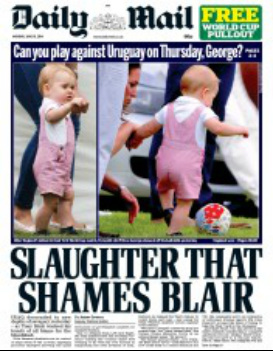Sometimes it helps to be a tabloid. The Mirror's graphic front is much more powerful than the Telegraph's excellent page one, which uses a photograph from the same set and runs an unusual two-line banner splash head.

Similarly, the Independent and Guardian share a different, less gruesome, picture, but it is more effective in the Independent, and even in the i, than in the Berliner format.

The Mail demonstrates the difference in the rules that apply to print - which has to attract casual readers and not upset those who have the paper delivered - and those that apply online.
The website's home page not only had the Iraqi execution pit, but also piles of bodies from Kenya and victims of atrocities in Afghanistan and Palestine. Not quite what people logging on for the sidebar of shame might be expecting at the top of the page.(It has now moved down.)
The mix on the Mail's home page as I write is incongruous, almost prurient - the McCanns upset about the adjournment of their Portuguese libel trial, followed by a teacher with cancer and Cheryl Cole's clothes immediately underneath, then a clutch of teasers for stories ranging from Michael Schumacher to a benefits cheat and a model who doesn't want to do community service.
Then comes the mass of bodies.
An attempt is made to show the relative importance of the stories by the amount of space they are given, but the mix still jars.
And so it does in print: the sanctimonious headline about the "slaughter that shames Blair" underneath three-quarters of a page of pictures of Prince George. Has this strange marriage come about because of the desire to sell papers on the back of the footballing baby royal or the fear of frightening the readers with pictures of the dead and dying?
The website's home page not only had the Iraqi execution pit, but also piles of bodies from Kenya and victims of atrocities in Afghanistan and Palestine. Not quite what people logging on for the sidebar of shame might be expecting at the top of the page.(It has now moved down.)
The mix on the Mail's home page as I write is incongruous, almost prurient - the McCanns upset about the adjournment of their Portuguese libel trial, followed by a teacher with cancer and Cheryl Cole's clothes immediately underneath, then a clutch of teasers for stories ranging from Michael Schumacher to a benefits cheat and a model who doesn't want to do community service.
Then comes the mass of bodies.
An attempt is made to show the relative importance of the stories by the amount of space they are given, but the mix still jars.
And so it does in print: the sanctimonious headline about the "slaughter that shames Blair" underneath three-quarters of a page of pictures of Prince George. Has this strange marriage come about because of the desire to sell papers on the back of the footballing baby royal or the fear of frightening the readers with pictures of the dead and dying?
The only way these shock stories work is if you give the whole page to them, as the Mirror and Independent have. Ideally, the puff should also go because there is nothing that can sit alongside these sorts of stories and images without looking trite.
And of course there is also the old question of should we print pictures of corpses? It seems that act of discretion has been abandoned. But if we want people to buy our papers, take them into their homes and encourage their children to become newspaper readers, then we should be thinking carefully about what we print and how we print it.
And of course there is also the old question of should we print pictures of corpses? It seems that act of discretion has been abandoned. But if we want people to buy our papers, take them into their homes and encourage their children to become newspaper readers, then we should be thinking carefully about what we print and how we print it.



 RSS Feed
RSS Feed


